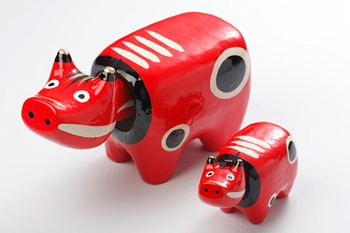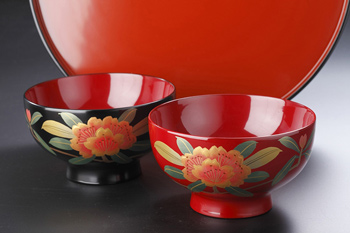Fukushima Crafts
Fukushima Prefecture has a proud heritage of traditional arts and crafts, which happen to make great souvenirs. Don’t miss out on the chance to learn more about these incredible Fukushima works. Many locations also offer the chance to make or design your own versions too.
Craft Varieties
 |
AkabekoAkabeko red cows are easily recognizable from their friendly, bobbing heads. Usually made from papier-mâché, Akabeko are popular crafts from the Aizu region, which are thought to bring good luck and strength. Read more about the history of these cute cows here. |
 |
Tsuchiyu KokeshiTsuchiyu kokeshi dolls are distinguishable from kokeshi from other areas of Japan due to their smaller-sized heads, thin bodies, distinctive wide-set eyes, rounded noses, and small mouths. You can design your own kokeshi when you visit Tsuchiyu Onsen. |
 |
Shirakawa DarumaMade in Shirakawa City since the Edo era, Shirakawa Daruma are decorated with lucky symbols: the eyebrows look like cranes, the moustache shaped like two turtles, the beard drawn in the shape of bamboo or pine branches. One traditionally decides on a goal and paints one of the eyes. The remaining eye is to be completed once the goal is fulfilled. |
 |
Okiagari KoboshiOkiagari Koboshi dolls are made from papier-mâché, and are generally around 3 cm in height. These little dolls represent perseverance; even if they are knocked over, they stand right back up, symbolizing the wisdom of the old saying "If at first you don't succeed, try, try again." There is a custom in Aizu-Wakamatsu City of buying Okiagari Koboshi as good luck charms to bring prosperity and safety for one's family from the first market held in the New Year. Traditionally, you buy one more doll than the number of people in your family. |
 |
Kami-Kawasaki WashiHandmade Kami-Kawasaki Washi paper is famous for its history of over 1,000 years. It was given the name 'Kami-Kawasaki Washi' because of its origin in Nihonmatsu City's Kami-Kawasaki district. It has been used regularly as shoji paper (paper for sliding doors). Many people are charmed by the warmth and simple beauty of Kami-Kawasaki Washi. You can try making your own washi paper during your visit to Nihonmatsu City. |
 |
Miharu-komaMiharu-koma are wooden toy horses made in Miharu Town, which range from 3 to 30 cm in size. Even today, Miharu-koma continue to be beloved toys for many children. Wood is carved into the shape of a horse and, after being painted black and white, it is decorated with bright red, black, and gold patterns. Finally, a stiff, brush-like tail is attached. Miharu-koma painted all in white are used as lucky items to bring longevity. Design your own at Takashiba Dekoyashiki. |
 |
Aizu LacquerwareProduction of lacquerware in the Aizu region was first created initiated in 1590 by Gamo-Ujisato, the feudal lord of the Aizu Domain. At the behest of Hideyoshi Toyotomi, Gamo-Ujisato invited specialist woodworkers and lacquer artisans to Aizu from Hino in the Omi Province (present-day Shiga Prefecture). He did this in order to spread their techniques throughout the region. Successive generations were encouraged by their feudal lords to continue the traditional. Current day artisans make a range of items including tableware, vases, writing materials, tea utensils, and Buddhist altar fittings. Aizu lacquerware is one of Japan's preeminent names in lacquerware. Visitors to Fukushima can try their hand at decorating Aizu lacquerware. |
 |
Aizu Painted CandlesAizu Painted Candles have been made in the Aizu region for over 500 years, and are most often decorated by hand with floral designs. Aizu used to be a major producer of lacquer trees. The sap of these trees was needed to make lacquer, and the leftover berries were used to make candle wax, which would eventually be decorated as an 'erosoku' ('painted candle'). A festival is held annually in February to celebrate the history of this traditional craft. |
 |
Obori SomayakiObori Somayaki is the name given to porcelain produced in Namie Town (formerly known as Obori Village) on the coast of Fukushima Prefecture. Initially produced by farming families for supplementary income, Obori Somayaki's history dates back to the Edo era. It is known for its distinctive blue fissures and a 'running horse' motif. In its heyday, there were over 100 Obori Somayaki producers. After the disasters of March 2011, many kilns were forced to close or relocate, reducing the number of kilns to as low as 10. |